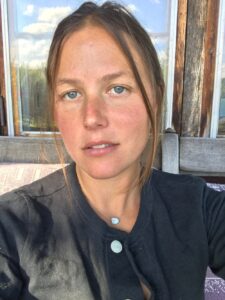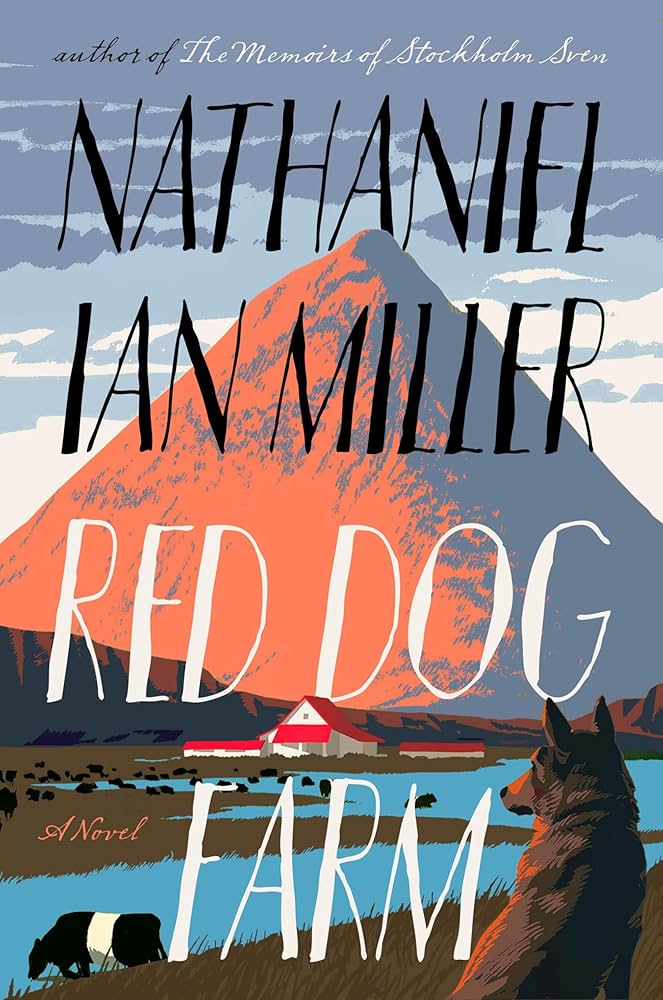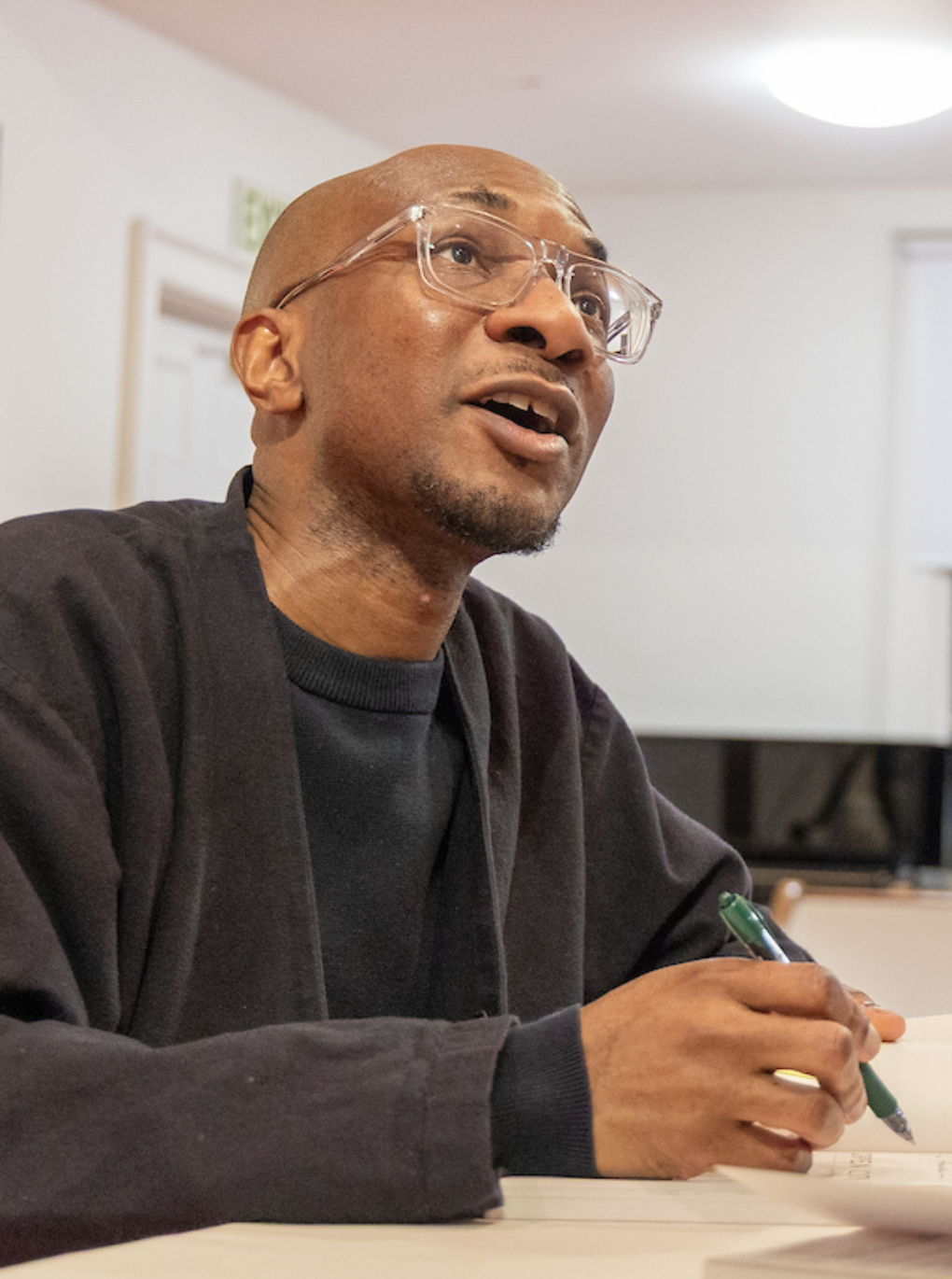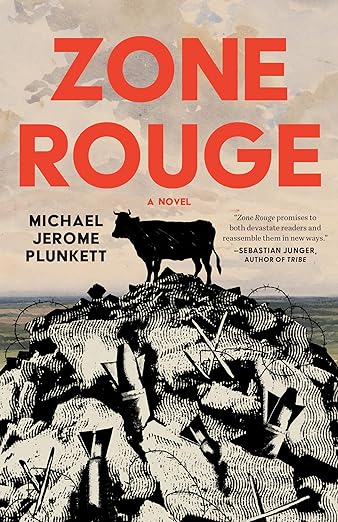JOANNE McFARLAND is an artist, poet, and curator whose work centers on the intersection of language and visual representation. Her newest collection, Pullman (Grid Books, 2023), is a brilliant and singular exploration of form and artistic disciplines that examines themes of labor, creativity, eroticism, and love, engaging and interacting with events in the American past as they relate to the state of being human today. By exploring the history of the Pullman car porters of the late 19th-century railroads, McFarland’s poems and integrative collages explore historical sources, entries from the Black Almanac of 1972, lyrics created by McFarland’s own father—a songwriter for Aretha Franklin—and vintage French magazines. In this interview, MAKENNA GOODMAN connected with McFarland about Pullman and the broader scope of her artistic work. McFarland asks us to consider our relationship to the erotic, to our delight, to the sensual experience of being alive, to our drive to make music from a moan, to adhere ripped pages into re-imagined dresses, to reconsider the past as a way out of pain.
Makenna Goodman: Pullman begins with a short piece of expository-esque writing about the Pullman Car Company, which operated railroad cars during the late 19th century, and whose porters were mostly African-American men. You introduce The Brotherhood of Sleeping Car Porters, one of the most influential labor unions of the 20th century, whose members included thousands of Black porters. Then the table of contents is followed by the first poem, “Sleeper,” whose beginning reads: Don’t break into this poem. / Please, just let it be. / Let it arrange itself without your intervention. The reader opens the book and is immediately confronted with the facts of the past, followed by a demand that we rethink our way into the work. Later in the poem, you write: “Every poem I write is a lullaby. / Once upon a time there were men who helped other / men reach their destinations. / They carried their coats and cases, served them their / meals and liquor, then tucked them up in their beds. / This poem prepares you to let your guard down, / that’s its job. / It treats you like a child. / They treated them like children…” Can you talk about your interest in the Pullman Car Company, and what led you to write a book with it as a central inquiry?
JoAnne McFarland: Growing up, I knew how much the Pullman Porters meant to Black families. I appreciated how hard A. Philip Randolph fought to secure The Brotherhood of Sleeping Car Porters. I wanted to set up right away that we don’t survive on our own, that we are all interconnected, and often stronger together than alone. The more threatened we are, the more dangerous the times, the more we need each other to make sense of life and activate our individual potential. I see our current social and political environment as extraordinarily toxic. Pullman grew out of my recognition of what Black people have been through in this country, and my belief in community-building as a strategy for healthful living.
The opening poem, “Sleeper,” directly addresses how a community is composed of unique individuals, each with something special to contribute. My experience of the world is shaped by everything and everyone that has happened to me alone. What I create is evidence of my singularity. I have a kind of awe for the clarity each life holds, and my art-making is fueled by this respect. I believe works of art, in a way, build themselves. All too often we lack faith in this magical process.
In particular, I write poems to soothe myself and others. I make songs that allow me to relax into an experience, to enter an erotic playful state of mind. In this state, anything seems possible. All of my poems are lullabies in that they describe real worlds that often contain elements of threat while reinforcing the indestructible power of creativity and beauty.
MG: The second poem in the book, “Pathfinder,” incorporates excerpted text from Incidents in the Life of a Slave Girl, Harriet Jacobs’s seminal autobiography about life as an enslaved woman in the antebellum era, including a detailed account of sexual abuse, her struggle to protect her children, and mothering through the horrors of enslavement. You layer your poem on top of Jacobs’s words, in white text, creating a striking image: yours and Jacobs’s words as both inherently linked and singular. History, as it were, is made visible through the implementation of shades of color: gray, darker gray, and white. I found the choice of dark gray text to invoke Black, too, as a felt but unseen color, that takes the shape within the emotion and experience of what the words recall. Can you speak about these visual choices in Pullman? Visual art is central to your work and life, and I’d love to know how it plays both into this book and your oeuvre as a whole, both conceptually and practically.
JM: “Pathfinder” speaks to my belief that violence and creativity are opposites. Every violent act I can think of is oriented in the past and grows out of a belief system that already exists. A violent act seeks to control, to stop something from happening. Creativity, by its very definition, is oriented toward the future, using current resources to manifest what we can imagine, or, sometimes what we didn’t even know was possible.
I experience creativity as erotic, unbounded, life-affirming. “Pathfinder” expresses my personal struggle, which I see reflected in the lives of every single woman I know, to be a free agent, to be connected to a partner, and others, but to live without fear, motivated by curiosity and faith in the unknown.
“Pathfinder” melds Harriet Jacobs’s historical enslavement with the contemporary restrictions many women still experience. My use of white text to ride on top of a darker background is a visual way to describe the Herculean task of breaking free of others’ expectations.
MG: I admire the way you rock a lyric from side to side. As in the first line of “Labor”: This is the way / my life goes / My life is on this track / Life goes this way and back / … And then later: I leave skid marks / on the table / Its roar lifts my haunches / this lick that lap / so rank / My insides steeped in hisses / It has a pretty heart / she chimes / she pins the scan / to my map… I couldn’t decide if this poem was about laboring through an abortion or birth, and yet motherhood—the labor of it—can be so inherently violent, and invoke in women (especially women who have been harmed through sex) such a sense of humiliation and ambivalence. Can you discuss your approach to exploring the labor of being a woman in your work?
JM: The poem “Labor” is about all the things you mention! It exemplifies what I mean when I say poems make themselves up. All of the parts are present and accounted for, but the narrative remains open to interpretation. This could be the story of one woman, or four, or fifty. I wanted to have a section in Pullman called Labor to refer to the Brotherhood which was a labor union. But for women, labor can mean something else entirely.
The subject matter of the poem is intense—heavy, and so working through those four pages is laborious, a bit dreadful. I foreground the theme of agency, particularly women’s agency. A woman who expresses her passion for living can become trapped by her own body, by a pregnancy she isn’t prepared for, or doesn’t want. Motherhood can derail her plans, or subvert her personal wishes for decades, or a lifetime.
Poetry is an incomparable tool for freeing oneself from trauma.
I’m intrigued by how often women are made to pay for their passions, as if female desire contaminates, rather than uplifts. It requires enormous courage and introspection to dissect who is served when women bank themselves down, when they give their time and energy away or have it stolen outright.
The section “Labor” unfolds against the backdrop of actual menus from Pullman trains. I contrast a lifestyle of ease and unfettered movement with the real limits many women still face.
MG: In “Whistles & Stops,” the final chapter/poem of the book, you offer a collage of form: song lyrics written for Aretha Franklin by your father, the composer John L. McFarland, and a listing of facts from The Black Almanac of 1972 (known then as The Negro Almanac) paired with your stunning collages of reimagined dresses. History, again, is a central voice, as is visual art and song—you seem to be asking us to consider what one would be without another. I’d love to hear more about these decisions you make when it comes to juxtaposition.
JM: I love your choice of the word “reimagine”! I hope the final section, “Whistles & Stops,” leaves the reader with a fresh concept of what a poem or an aesthetic experience can be. By letting one’s guard down, maybe a new way of seeing is possible. “Whistles & Stops” pays homage to my belief that creativity triumphs over violence, and that progress toward greater equality is being made.
The section is poetic in that it does what all poems do—sort and synthesize experience in order to find meaning. I chose the dress collages to allude to the spiritual power of women, and in particular the grandeur of Black women. The words in my father’s songs that bookend the section speak to the rich history of support within Black communities, often overlooked by the larger culture. The Negro Almanac of 1972, a three-inch thick book from which I chose the highlighted facts, overflows with Black history and achievement. I wanted to end Pullman with a “train” that would underscore the breadth of the American landscape and the possibilities still before us.
MG: That’s a fascinating idea, to consider poetry as a tool with which the poet can sort and synthesize experience in order to find meaning. When did you first discover that that’s what you were doing? And when did you begin writing?
JM: I use poetry as a way to find out what I really believe. More than any of my other artistic pursuits, when I’m writing poetry, I’m able to allow my psyche to drive and take me into new territory. I believe, without question, what is revealed during these journeys. I’ve come to understand that my poems foretell who I will be a year or two down the road. In the case of Pullman, this means a further letting go of ego and focusing on my commitment to community as a way of surviving trauma.
Assigning meaning to experience is the linchpin of agency.
I’ve been making art for as long as I can remember. I’ve always been aware of the value of making things, and how immersion in the creative process is unique. I’ve never understood why the arts are so devalued within American society. My work arises from the tension between how deeply I treasure creativity as a mode of being, and how little support I see for it as a source of human wealth.
A poem seeks to solve a puzzle, to integrate the pieces of an experience into a whole. Assigning meaning to experience is the linchpin of agency. Trauma, which often results from violence, is characterized by “stuckness” by an inability to integrate the pieces of an event so that they make sense. Poetry is an incomparable tool for freeing oneself from trauma.
MG: Who are poets that have informed your work? What artists have inspired you?
JM: As it happens, my work tends to be most influenced by philosophers. I’m fascinated by bold thinkers who enter mental territories I experience but don’t always understand. Martin Heidegger’s Poetry, Language, Thought is a seminal work for me, one I return to again and again. Also, Rainer Maria Rilke’s On Love and Other Difficulties—a great book, and a great title! I’ve learned so much from Mary Oliver’s A Poetry Handbook which is loaded with information; there’s a warmth and clarity in the tone of this slim volume that’s always just what I need for grounding which is what I’m looking for, particularly when I’m building up courage to try something new.
I read more poetry than anything else. I have a terrific collection of poetry books, with both past and current writers; and I love love love looking at art! My one rule is to always find something, no matter how ephemeral, in an artist’s work. I assume that every maker has something for me; it’s my job to be open enough to find it. Some worlds are easier to enter than others, but there’s always an idea, or a few sounds, or an image that will expand what I already believe. This attitude informs how I curate exhibitions and has developed into a key part of my artistic life.
MG: I’m interested in your reference to philosophy, and especially Heidegger. Do you see poetry as playing a similar role in the desire to shift our global consciousness? Can you talk more about the intersection between philosophical texts and your work?
JM: I’m drawn to works that wrestle with how complex the human mind is. I want to understand how a sense of threat, or a sense of ease, is constructed. Each of us is capable of tremendous emotional breadth and myriad actions, but most cultural messages seek to narrowly categorize our lives and experiences, not broaden them. As I’m working, I’m deciphering what has happened to me to see how I fit into the existential puzzle of being human.
Many years ago, when I first discovered the book Poetry, Language, Thought by Martin Heidegger, I didn’t know about his history with the Nazi Party. I cannot resolve that history with the wide open sky of his thoughts on being. In a way, this takes me back to what I said about my work as a curator—I try to pull something of value from everything I encounter, everything I’m offered. That sometimes means that I’m deeply unsettled, even shaken. I’ve never met an artist who is cavalier about their world. Every artist I know is in deadly earnest about what they’re doing. I’ve seen artists weep when they feel that something ineffable about how they view the world is truly seen.
MG: Can you discuss your collage process? What materials do you use, and how do you approach the making of your work? Is it a similar impulse to that of writing poems, or do you pull from another wellspring?
JM: I use my dress collages as my sketchbook. They’re how I play with color, and pattern, not so much form which I emphasize in my oil paintings. My dress collages are darkly humorous and political. I’m often thinking “Oh, that’s so funny” while I’m making them, which I’m never thinking when I’m painting. They’re a way for me to relax and not take myself so seriously, which I constantly have to remind myself.
I have a huge cardboard box of papers—rice papers, French wallpapers, comic books, origami papers, botanical prints, antique sheet music, and a whole stack of the French journal L’Illustration from 1900, a gift from a stranger twenty years ago after he came to one of my open studios. I open up the box and start to play. I’ve been doing the series for twenty-five years, and it’s been wonderful to see how the collages have evolved over time. Current ones have much more text in them than they did in the beginning. Earlier pieces were much more abstract and monochromatic.
Once I have an arrangement I like, I trace the pieces very lightly with graphite, then cut them to fit. I’m essentially making a puzzle. Then I glue the pieces in place (YES paste is my favorite glue). I cover the collage with clean paper and weigh it down with heavy books so that it dries flat. The title for the dress usually comes to me right at the end. I love naming them! I always know just what a dress should be called. It’s usually something funny, erotic, or both.
MG: Can you discuss more your interest in the erotic, or eros, and how it plays into your work? Do you believe that eros is inherently political?
JM: I really appreciate this question since all of my work comes from my sense of what erotic means. I’m one hundred percent aligned with Audre Lorde’s profound insights in Uses of the Erotic: The Erotic as Power. She’s another thinker whose work I return to again and again. When I originally read this essay, I was blown away by how Lorde articulated with such clarity something I’d felt for decades.
When I refer to something as erotic, I mean that it’s life-affirming, marked by curiosity and delight. I do not at all mean sexual, which is the more common understanding. I’ve always experienced this limited definition as a box that women are often put into, or put themselves into rather than experience the free fall that can characterize true eroticism.
In Pullman, the very first lines allude to my comfort with the creative process which is the most erotic thing I can think of. When I say don’t change this poem, please just let it be, I’m declaring my faith that the poem will end up delighting me, and maybe you, if only we can allow it to happen. Delight is a state of utter responsibility, presence, and abandon. In the best of all possible worlds, both the maker and receiver are willing to enter this state. This synchronicity is the foundation of a peak aesthetic experience, one that vibrates across time and space.
Few people are willing to allow themselves to fall in love with anything. We’re trained in “critical thinking,” which is a distanced attitude, rather than approaching the unknown with a sense of curiosity and fearlessness. Not being afraid is unbelievably thrilling. It can be almost, almost, too much to bear. But once you survive a few moments of it, there’s no going back.
Delight is a state of utter responsibility, presence, and abandon.
Makenna Goodman is the author of The Shame (Milkweed, 2020) and has written for publications including New York Review of Books, Los Angeles Review of Books, Literary Hub, Catapult, White Review, Harvard Review, BOMB, Astra Magazine, and others.
JoAnne McFarland is a multidisciplinary artist and writer, and the Artistic Director of Artpoetica Project Space in Gowanus, Brooklyn which exhibits works that focus on the intersection of language and visual representation. McFarland has artwork in the permanent collections of the Library of Congress, the Columbus Museum of Art, and the Department of State, among many others. In addition to Pullman (Grid Books, 2023), her collections include: Acid Rain (Willow Books, 2012), 13 Ways of Looking at a Black Girl (Gold Leaf Books, 2011), Identifying the Body (The Word Works, 2018), and the digital album Tracks of My Tears (The Word Works, 2020). McFarland has had fellowships at the BARD Graduate Center Library, KALA Art Institute, the National Arts Club, and the Painting Center. Her ongoing traveling project Sally, a collaboration with artist Sasha Chavchavadze, explores the histories of women whose lives have been marginalized, or forgotten. The Sally Project has traveled to nine venues throughout the United States featuring the work of over fifty artists.

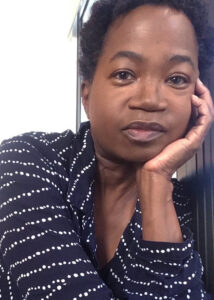 .
. 